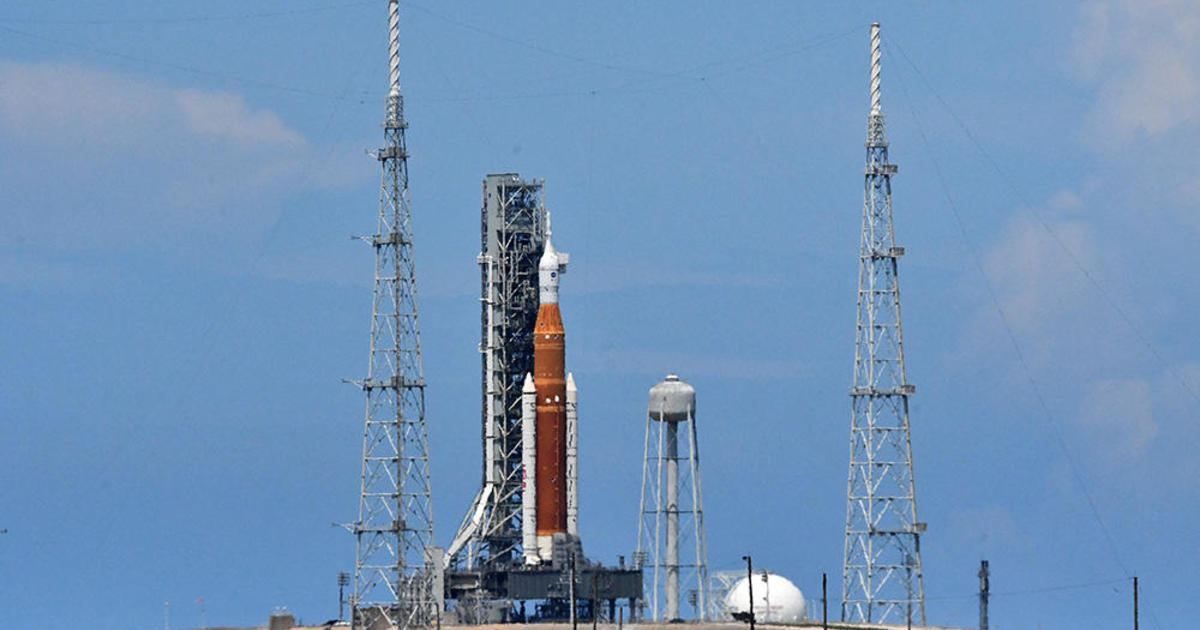With one week to go until launch, mission managers met Monday to review preparations for the unpiloted maiden flight of NASA’s huge $4.1 billion Space Launch System rocket, a 322-foot-tall behemoth the agency is counting on to return American astronauts to the moon.
Assuming no unexpected issues, managers are expected to give the launch team clearance to press ahead toward start of a 46-hour 10-minute countdown at 10:23 a.m. EDT Saturday, setting the stage for blastoff at 8:33 a.m. Monday, the opening of a two-hour window.
“Am honored to attend the @NASAArtemis flight readiness review today,” tweeted Thomas Zurbuchen, NASA’s director of space science. “Many years in the making, thousands of individuals doing their best – we are getting to this important milestone.”
Am honored to attend the @NASAArtemis flight readiness review today. Yes, NASA Science is there with #TeamArtemis. Many years in the making, thousands of individuals doing their best – we are getting to this important milestone. Love that the @NASA_Astronauts are attending also! pic.twitter.com/E5BTXoucAU
— Thomas Zurbuchen (@Dr_ThomasZ) August 22, 2022
The SLS is the most powerful operational rocket in the world, eclipsing the legendary Saturn 5 rocket that propelled Apollo astronauts to the moon.
Generating 8.8 million pounds of thrust from two extended solid-fuel boosters and four upgraded Aerojet Rocketdyne RS-25 engines, the 5.5-million-pound SLS rocket is expected to hit 100 mph — straight up — in about seven seconds, putting on a ground-shaking spectacle for thousands of spaceport workers, area residents and tourists.
If all goes well, the Boeing-built core stage, Northrop Grumman strap-on boosters and an upper stage provided by United Launch Alliance will propel an Orion crew capsule around the moon and back. The 42-day mission is expected to end with a Pacific Ocean splashdown west of San Diego on Oct. 10.
The Space Launch System moon rocket atop pad 39B at the Kennedy Space Center.
William Harwood/CBS News
The top priority of the Artemis 1 mission is to test the Lockheed Martin-built capsule’s 16.5-foot-wide heat shield and its ability to protect the craft when it slams into the atmosphere on Oct. 10 at some 25,000 mph, enduring temperatures up to 5,000 degrees before a parachute descent to splashdown.
Successfully launching the SLS is built into that top priority because it’s the rocket that will provide the energy to boost the Orion capsule beyond the moon to set up that fiery, high-speed re-entry.
Years behind schedule and billions over budget, the rocket’s maiden launch is a long-awaited milestone, but timing is critical. Based on the constantly changing positions of Earth and moon and the requirements of Orion’s planned trajectory, NASA has a very limited number of launch opportunities within a given period.
If the SLS rocket can’t get off the ground next Monday, the launch team will only have two other opportunities, on Sept. 2 and 5, before the end of the current launch period and a trip back to the Vehicle Assembly Building for work to service self-destruct system batteries and other systems.
The next launch period opens on Sept. 19 and closes Oct. 4, but it’s doubtful the rocket could be returned to the pad in time for a countdown and launch attempt. More likely, NASA would be forced to aim for the launch period after that, which opens Oct. 17 and runs through Oct. 31.
Mission managers are hopeful it won’t come to that, and Launch Director Charlie Blackwell-Thompson, the first female to serve in that position, says she’s confident her team is up to the challenge, weather permitting.
“I think we have done all of the things that you can do to be ready,” she said in an interview with CBS News. “The flight hardware, it lets you know when it’s ready to fly. … I think it’s ready. But on launch day, I’ll know.”
Bill Harwood has been covering the U.S. space program full-time since 1984, first as Cape Canaveral bureau chief for United Press International and now as a consultant for CBS News. He covered 129 space shuttle missions, every interplanetary flight since Voyager 2’s flyby of Neptune and scores of commercial and military launches. Based at the Kennedy Space Center in Florida, Harwood is a devoted amateur astronomer and co-author of “Comm Check: The Final Flight of Shuttle Columbia.”
